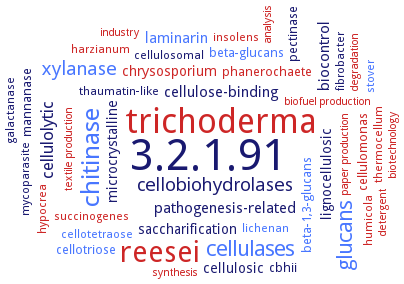3.2.1.91: cellulose 1,4-beta-cellobiosidase (non-reducing end)
This is an abbreviated version!
For detailed information about cellulose 1,4-beta-cellobiosidase (non-reducing end), go to the full flat file.

Word Map on EC 3.2.1.91 
-
3.2.1.91
-
trichoderma
-
reesei
-
chitinase
-
cellulases
-
glucans
-
xylanase
-
cellobiohydrolases
-
cellulolytic
-
biocontrol
-
pathogenesis-related
-
laminarin
-
cellulose-binding
-
lignocellulosic
-
saccharification
-
chrysosporium
-
cellulosic
-
microcrystalline
-
pectinase
-
beta-1,3-glucans
-
cbhii
-
beta-glucans
-
mannanase
-
cellulomonas
-
cellotriose
-
phanerochaete
-
hypocrea
-
succinogenes
-
humicola
-
harzianum
-
cellotetraose
-
galactanase
-
thermocellum
-
lichenan
-
mycoparasite
-
fibrobacter
-
thaumatin-like
-
cellulosomal
-
stover
-
insolens
-
biotechnology
-
synthesis
-
textile production
-
paper production
-
industry
-
detergent
-
degradation
-
analysis
-
biofuel production
- 3.2.1.91
- trichoderma
- reesei
- chitinase
- cellulases
- glucans
- xylanase
- cellobiohydrolases
-
cellulolytic
-
biocontrol
-
pathogenesis-related
- laminarin
-
cellulose-binding
-
lignocellulosic
-
saccharification
- chrysosporium
-
cellulosic
-
microcrystalline
- pectinase
- beta-1,3-glucans
- cbhii
- beta-glucans
- mannanase
- cellulomonas
- cellotriose
- phanerochaete
- hypocrea
- succinogenes
- humicola
- harzianum
- cellotetraose
- galactanase
- thermocellum
- lichenan
-
mycoparasite
-
fibrobacter
-
thaumatin-like
- cellulosomal
- stover
- insolens
- biotechnology
- synthesis
- textile production
- paper production
- industry
- detergent
- degradation
- analysis
- biofuel production
Reaction
2 cellohexaose
+
2 H2O
=
2 cellotriose
+
Synonyms
1,4-beta-cellobiohydrolase, 1,4-beta-D-glucan cellobiohydrolase, 1,4-beta-glucan cellobiohydrolase, 1,4-beta-glucan cellobiosidase, avicelase, avicelase II, beta-1,4-glucan cellobiohydrolase, beta-1,4-glucan cellobiosylhydrolase, beta-1,4-glycanase, Beta-1,4-glycanase CEX, Beta-glucancellobiohydrolase, C1 cellulase, CBH, CBH 1, Cbh C, CBH I, CBH Ib, CBH II, CBH IIb, CBH1, CBH2, Cbh6B, Cbh9A, CbhA, CBHI, CBHII, Cbhl.2, CBM3-GH5, CBP120, CBP95, CbsA, Cel5A, Cel6, Cel6A, Cel6B, Cel6C, Cel7A, Cel7D, CelA, CelAB, CelB, CelC7, CelK, cellobiohydrolase, cellobiohydrolase 1, cellobiohydrolase 9A, cellobiohydrolase A, cellobiohydrolase class II, cellobiohydrolase I, cellobiohydrolase II, cellobiohydrolase, exo-, cellobiosidase, cellobiosidase, 1,4-beta-glucan, Celluclast 1.5, Cellulase, cellulase, C1, Cex, Csac_1078, Ex-1, Ex-4, exo-1,4-beta-D-glucan cellobiohydrolase, exo-1,4-beta-D-glucanase, exo-beta-1,4-cellobiohydrolase, exo-beta-1,4-glucan cellobiohydrolase, exo-cellobiohydrolase, exocellobiohydrolase, exocellulase, exocellulase E3, exoglucanase, GH5, glucanase, Huta_2387, More, nonreducing end-acting cellobiohydrolase, oligosaccharide-specific cellobiohydrolase, PSCase, SCO6546, Ta Cel7A, THITE_126432, TTCBH6B


 results (
results ( results (
results ( top
top





